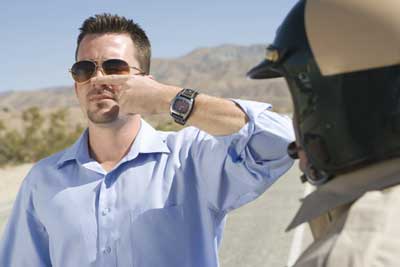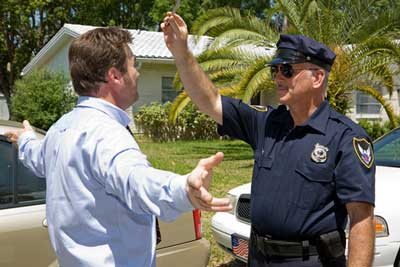A Field Sobriety Test is a test performed by a police officer for someone being evaluated for Driving Under the Influence (DUI). Most often these tests are carried out on the side of the road and the information that is gathered in these tests will form the most important part of the evidence used to prove a DUI. If you end up being charged with DUI you will need the help of one of our Portland DUI lawyers.
There are two major categories of Field Sobriety Test, also known as “FSTs”. These are the Standardized Field Sobriety Tests, or SFSTs and the non-standardized field sobriety tests.
Page Contents
Standardized Field Sobriety Tests
Scientific studies were performed many years ago to determine the likelihood that an individual was intoxicated based on their capacity to complete three different sobriety tests, so long as these tests were administered in a standardized way. These tests are the Horizontal Gaze Nystagmus Test, the One-leg Stand test and the Walk and Turn test and are commonly referred to as the Standardized Field Sobriety Tests or SFST.
The premise is that if the officer administering the tests does so in a consistent standard way and looks for the exact same clues each time, these tests are fairly accurate and hold weight in a court of law, based on the outcomes of those initial studies.

Horizontal Gaze Nystagmus (commonly referred to as “HGN”)
As long as this test is performed correctly, the HGN is possibly the most accurate of all the Standardized Field Sobriety Tests. Nystagmus is a jerking of the eye that occurs involuntarily and can be a sign of intoxication.
There are different types of Nystagmus and some people develop this condition naturally. The nystagmus being identified in the HGN is not the same as naturally-occurring nystagmus. Horizontal Gaze Nystagmus is only the result of consuming certain intoxicants especially alcohol.
Nystagmus is an involuntary reaction so the person being tested may not know if they have this condition or not, the brain works to balance out the movement so it happens without the person knowing.
In the HGN, the officer will ask the person being tested to stand straight with their hands at their sides and feet together. They will then ask the person to follow a stimulus with their eyes, this can be a pen or the officer’s finger.
As the person follows the stimulus with their eyes the officer will be observing their capacity to follow instructions and not sway their body with the motion of their eyes, but this is not the most important thing the officer will be looking for. The officer will be watching the eyeballs of the motorist being tested. There are a total of six clues the officer will be looking for three in each eye.
If the officer notices four or more of these clues, the officer will assume the person was unable to complete the test and is in fact intoxicated.
The Walk-And-Turn Test
From the perspective of a concerned citizen, we would all like to rest assured that these tests are infallible in their indication that someone is inebriated. The truth is that many times a person with an acceptable level of alcohol according to the breathalyzer test will fail one of the Standard Field Sobriety Tests.
This often happens because they didn’t fully understand the officer’s instruction or were scared and nervous during the test and this affected the outcome. The Walk-and-Turn test is one such example.
This is the test that many people think of as the ‘walk the line’ test and assume the point of the tests it demonstrates one’s capacity to walk in a straight line. Actually, staying straight and keeping balance is only one of 8 different signs the officer will be looking for when administering this test and it is possible to fail completely before you even take a single step.
Here are the instructions you can expect to hear from an officer administering the ‘Walk-and-Turn’ sobriety test, these verbal instructions are taken from the official training manual.
“Step on the line with your left foot. Place your right foot ahead of your left foot on the line, keeping the heel of your right foot up against the toe of your left foot. Keep arms down by your sides and hold this position until I tell you to begin. Do you understand these instructions so far?”
“When I tell you to start, take nine heel-to-toe steps, turn, and then take nine heel-to-toe steps back. When you make the turn, keep the front foot on the line, and turn by taking several small steps with the other foot.
“While you are walking, keep your arms at your sides, watch your feet at all times, and count your steps out loud. Once you start walking, don’t stop until you have completed the test. Do you understand the instructions?”
The person taking the test will be allowed a single error, or what the officer will call a “clue”. But if they commit more than one error, this will be understood as a failure of the test. Here are the eight things an officer will be looking for when administering the Walk-and-Turn.
- Inconsistent heel-to-toe contact throughout the entire test
- Beginning the test before being told “begin;”
- Pausing for several seconds at any point after the test has begun;
- Missing heel-to-toe contact by more than ½ an inch during any step;
- Stepping off the line by more than 3 inches during any step;
- Lifting one or both arms more than six inches from their side;
- Turning incorrectly – removing the front foot from the line while turning is a clue, as is spinning or pivoting the turn;
- Taking more or fewer than nine steps.
The walk-and-turn test is not a precise one and someone who has failed the test may or may not be under the influence of intoxicants. There are many instances when a person taking this test will fail because of nerves or stress or because they aren’t sure how they will be graded.
The One-Leg Stand Test
The last of the three SFST is the One Leg Stand Test. To begin with, the officer will instruct the person to stand with their arms at their sides and their feet together. Next, the officer will give the following instructions:
“Raise one leg approximately six inches off the ground keeping your foot pointed out. Keep both legs straight with your arms at your side. While maintaining this position, count out loud in the following manner: “one thousand and one, one thousand and two, one thousand and three, until told to stop.” Keep your arms at your sides at all times and keep watching the raised foot.”
Once again the person taking these tests is allowed to make a single mistake or a clue. If the officer sees more than one clue during the test they will assume the driver has failed. Here are the clues an officer administering the One-Leg stand will be looking for.
- Swaying while balancing on one leg;
- Moving the arms more than six inches from their sides to keep balance;
- hopping while balancing
- putting the foot down without being told to.
The test is not supposed to last longer than 30 seconds but the person will not know this as they stand to count until the officer tells them to stop. According to the officer’s manual, they are supposed to stand as motionless as possible during the test so as not to interfere with the person’s balance. Of course, traffic passing by within ten feet of the person taking this test can make this ts much more difficult than it was originally designed to be.
Non-Standardized Field Sobriety Tests
Over the last two decades, there has been a great decrease in the use of non-standardized field sobriety tests used by police officers. There was a time not too long ago that a police officer could apply whichever tests they saw fit without any thought of the standardization or scientific validity of their test.
Over the past decades these tests have been used less and less, but may still be applied from time to time. Most often this will be by a senior officer who is remembering his training from long ago or by an officer administering the test to a person unable to take the other standardized test due to some specific disability.
Number Count Test
One common test is the number count test that involves asking the person being tested to begin counting backward from a random number to another random number selected by the officer. The officer may ask something like, “count backward from 96 to 69”. Other times officers will ask a person to count backward by threes or fours between two randomly selected numbers.
Finger Dexterity Test
In this test, the officer will ask the person they are testing to touch the tip of their thumb to the tips of their fingers while counting backward and forwards. Sometimes the officer will ask the person to use both hands for this test and other times they will ask the person to use only one hand.
Touch Your Nose Test
In this test, the person will be asked to lean back with their arms spread. Then when they are instructed they will touch their nose with the tip of their index finger.
The officer will call out “right” or “left” to indicate which finger to use. In Oregon, officers very rarely use this test in DUI investigations.
Most often, this test is used as a part of the DRE or Drug Recognition Evaluation, used to determine if the person is using a prescription or other controlled substance.

Alphabet Test
This test has been applied in different ways by different officers. The first, and maybe the more common and legitimate way, is to have the person suspected of DUI recite the alphabet forwards. The second method is more unusual and certainly an unfair and deceptive way of assessing the presence of intoxicants. This way involves asking the person to recite the alphabet backward.
The legitimate test will involve the officer asking the person to recite the alphabet forward between two random letters. The officer may ask the person to begin reacting at the letter “I” and stop at the letter “R”. But there can be no singing the alphabet song that was learned in school.
Then, there is the deceptive version of this test involves the officer telling the person to recite the alphabet between two random letters, but this time backward. There is only one reason that an officer would ask a person to do this and that is to get this common response “officer, I couldn’t do that sober”, which implies that the person was not sober at the time they were asked to take this test.
If You Have Been Arrested for DUI, Contact Trilogy Law Today
If you have been arrested in the Portland area for DUI, you will need expert legal support to mitigate the harshness of your ordeal. Contact the qualified lawyers at Trilogy Law Group to schedule your free consultation today.


